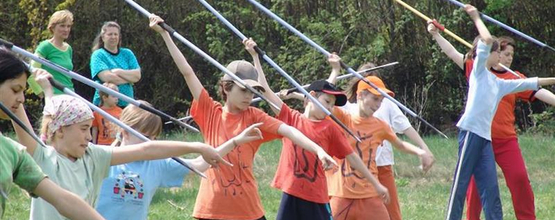Waldorf education in Slovakia
Although there has been a Waldorf school in Bratislava already during the 1930’s, the roots of today’s Waldorf movement in Slovakia actually do not reach that far back. It all started during the period of political changes after 1989, when the socialist governments collapsed, and Slovakia - then part of Czechoslovakia, along with other countries opened to the West. At that time, the Czechoslovak government had also invited people from the Netherlands to give lectures on Waldorf education. They came - and in some ways never actually went back. Helpful impetus arose from these beginnings eventually leading to alternative classes or schools.

The flow, from which the actual Waldorf school and the main impetus for the Slovakian Waldorf movement derived, was triggered by Cornelis Boogerd. During his many years of work he initiated the Slovakian Waldorf-Association, organized many courses in collaboration with frequently changing Dutch and Slovakian faculty assistants and founded the Slovakian Waldorf teacher training college.
The beginning of these seminar courses was indeed romantic. When Slovakian teachers with their low income were able to participate, they made great sacrifices. They for example slept in a kindergarten or in gyms, lectures were given in the cold socialist rooms of the university, eurythmy took place in halls with pillars in the middle of the room, the translation of the lectures was done by students who had never heard of Waldorf education and anthroposophy before, summer courses were organized in coordination with Czech friends and for practical experience they traveled to Dutch Waldorf schools - all that and much more is still alive in the memories of the first Slovakian Waldorf teachers.This was the basis out of which the Slovakian Waldorf movement developed. For a long time the most important question remained the practical implementation, the establishment of a school or a kindergarten. Several attempts in this direction depended on the quality of the people involved, on the moods of society and on authorities and legal conditions. Yet some of the first initiatives that had been approved by the authorities failed and partly overshadow the general opinion about Waldorf Education up to today.
Change then came along with Erich Šašinka, manager and chairman of the newly established Slovakian Anthroposophical Society. When he participated in the following Waldorf training course and joined forces with the most enthusiastic teachers, the idea of a Waldorf school slowly took shape. The school then found its place in Bratislava. Along with this initiative came the idea to also found a Waldorf kindergarten.
However, the Slovakian authorities criticized the planned curriculum. Nevertheless, the joint effort and enthusiasm of the people who were committed to the Waldorf idea was successful and the Ministry of Education approved the establishment of an elementary school and a kindergarten, though as part of an experiment: the elementary school as a private institution for a period of nine years and the kindergarten as an alternative class within a public kindergarten for a period of three years.
Even though the initiative in Bratislava remained the largest, the graduates of Boogerd’s teacher training spread to the many corners of Slovakia and the most active of them try to implement Waldorf education, even where they live. This is nowhere simple because Waldorf education is not certified by the state and meets a lot of rejection among people in the Ministry. A sentence of a government co-worker almost became literal: “Slovakia does not need Waldorf kindergarten, because the existing kindergartens are good enough”.
Thanks to the initiative of individuals and the courage of kindergarten leaders in Žilina and Zvolen (central Slovakia) groups developed that implement some Waldorf elements, but kindergarten initiatives that wish to be true Waldorf institutions, only have one option: They have to be non-governmental initiatives and may not formally work as kindergartens, but as a “kids clubs” – solely financed by contributions from parents.
However, the kindergartens have no officially approved curriculum, and although the evaluation results of the three-year experiment were internally positive, the authorities have not approved to the kindergarten up to today. Therefore, the efforts were directed towards obtaining permission for a private kindergarten. Again and again, the curriculum was revised according to the comments of the Ministry, repeatedly requests were made to include the “kids club” in the list of private kindergartens in Slovakia, but it was rejected again and again with various remarks. As a result, all the other Waldorf influenced initiatives remain “kids clubs” for the time being and continue to wait for official recognition and thus for possible state subsidies.

Bratislava
The only Slovakian Waldorf school in Bratislava is in 2007 entering its sixth year of existence with now 6 grades and 130 pupils in their own building and…
Learn more